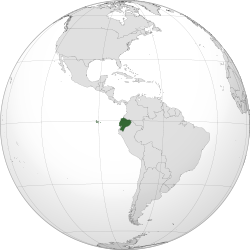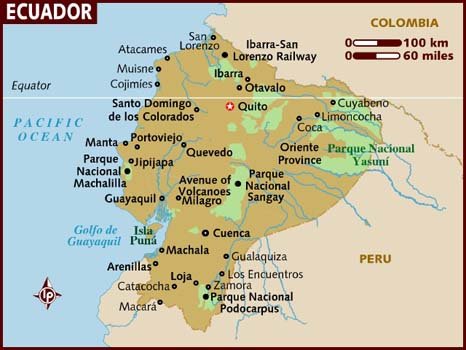Ecuador, which is formally called the Republic of Ecuador, is one of the nations in South America that do not share a border with Brazil. As compared to most Latin American cities, this city has one of the best conserved and less changed historical towns.
In addition to its richness in history, this country is also rich in flora and fauna, something that has made this country to be termed as one of the main 17 mega diverse nations globally. Ecuador is strategically placed between Colombia, Peru, and the Pacific Ocean. Most of its citizens use Spanish as their native language, although other local languages such as Quichua, Shuar, and eleven other languages are normally used (Central Intelligence Agency: CIA 1).

Basic Information
(Central Intelligence Agency: CIA 1)
History of Ecuador

The name Ecuador was coined in 1830, from the name “Equator, because the equatorial line passes through this nation. Historically, before the settling of the Incas in the area that came to be the present Ecuador, numerous Native American tribes from South- South America, North- South America and Central America had moved and settled in this area.
Although these groups had different cultures, they learnt to assimilate and live together, but there were slight differences between the settlers who lived in the coast and those who lived in the highland Andes.
As time went by, through the rising of numerous civilizations, numerous cultures, including the Valdivia Culture, Machalilla Culture, Quitus, and Canari came to exist. The arrival of the Incas in this area in late 1400s temporarily disrupted their form of life, but with time these settlers were absorbed into the Incas Empire, until when their organization was disturbed by the arrival of the Spaniards (Gerlach 12-53).
Position of Ecuador in South America

Colonization
The Spaniards arrived in Ecuador in the brink of the Inca Civil War in the year 1531. They were able to defeat the natives of Ecuador easily, because during this time, war and diseases had ravaged and torn the previous strong empire. Although it took time to fully conquer the natives of this land, by mid 1500s, Spaniards had established a very strong control over the natives.
During the first era of the Spaniard’s rule, Ecuadorians suffered from numerous ailments, which were the main reason for the high mortality rate. In addition to this, the oppressive way of ruling saw the killing of numerous Ecuadorians. It took roughly 300 years with the help of other South American colonies to topple the rule of Spaniards.
Under the leadership of José de Sucre, this nation gained its liberation from the Spaniards in the year 1822, although it was not until 1830 that it got liberated fully. After being liberated, this country with the help of the army remained under the rule of José de Sucre up to 1845 when he ran for his life, because of political instability. After this, the Liberal Oligarch took the leadership of this country until 1861 when Gen Gabriel García Moreno took over the leadership mantle (Lauderbaugh 35-49).
Although after independence, this country faced numerous challenges and was involved in war with its neighbors, more so during the Second World War, from the 1960’s, the country has enjoyed peace and stability; hence, it current development and maturity socially, politically and economically (Michigan State University 1).
Comparability Statistics and Charts with its South American Neighbors
Population comparability graph (2012)
Population percentage in Central America (2012)
(Central Intelligence Agency: CIA 1
Ecuador’s Exports and Imports
Some of Ecuador’s main natural resources include petroleum, fish, timber, and hydropower,and some of its main imports are industrial materials, fuels and lubricants, non-durable consumer goods. As a result of its richness in resources, this country exports products such as bananas, cut flowers, shrimp, cacao, coffee, wood, and fish.
Economic Makeup
Although Ecuador has improved in terms of its economy since independence, the rate of growth has fell short of what was expected for it to be able to fulfill the needs of its people. A number of uncontrollable events have stalled its economy development in the past, making it to deteriorate to an almost depressed state. However, to date Ecuador is the 8th largest economy in Latin America as it is a land that has been blessed with immense oil deposits. The country is also the largest exporter of bananas, with its export almost reaching the billion dollar mark as at 2002. Other major export products are flowers and fish (Martinez 1-7)
Effects from Crisis
This country’s crisis involved 16 banks and it was caused by a number of factors, major being poor market banking policies. The crisis causes a ripple in the economy, which made many to lose their confidence with the banking system and domestic currency.
As a result of this and due to the increase of the government’s liabilities and reducing of its domestic currency’s value, it adopted the dollar as its currency, as this was the only way of ensuring that the country conquered the market volatility. In addition, Ecuador’s government also sought for some economic support from other countries like China during this time, something which greatly aided its recovery (International Committee of the Fourth International 1).
Ecuador’s Foreign Affairs
Its main allies are neighboring nations such as El Salvador Venezuela, Bolivia, Russia, Brazil and Iran. This country has also strong ties with other international communities like USA, because of its good foreign policies (U.S Department of State 1).
Main Export Partners

Main Import Partners
Source: Central Intelligence Agency: CIA 1.
Trade Agreements
With Ecuador’s full support for free trade, it has embarked on partnerships with organizations and countries whose purpose is to enhance free trade. Ecuador joined such partnerships when it became a member of the World Trade Organization (WTO), the Latin Integration Association (ALADI) and the Andrea Community. Recently, the country has concluded bilateral agreement with some of its neighbors like Chile, Bolivia Venezuela and Colombia, and it is in trade talks with Mexico, Argentina, Brazil, Uruguay and Paraguay (Corniola 1).
Political System
Ecuador is a democratic nation and its leaders, including the president are normally elected by the people of Ecuador. Rafael Vicente Correa Delgado is the current president and is scheduled to lead the country until 2017.
Future prospects
With all its natural resources, Ecuador has to find ways to develop effective and consistent methods of earning revenue. To date, the country’s inefficiency has been its major inability to maximize production from its resources. Another hindrance is the price volatilities in the export market.
Despite these setbacks, diversification of its export market may be the best option for the country, in addition to its internal investment on industries. With all its resources at its deposal, if equipped with good governance, Ecuador will definitely have a bright future (Central Intelligence Agency: CIA 1.
Conclusion
In conclusion regardless of the numerous challenges that Ecuador has faced from time to time, this country has remained one of the richest nations in South America, because Ecuador’s historical richness and a booming economy has enabled it to always outshine its neighboring nations. With time with the current political stability, if better economic stimulus plans are put in place, the prospects of this nation being one of the richest nations in the world are high.
Work Cited
Corniola, Silvina. Trade agreement sought with E.U. Fish Information Services. 2012. Web.
Central Intelligence Agency: CIA. South America: Ecuador. 2012. Web.
Gerlach, Allen. Indians, oil, and politics: a Recent history of Ecuador. Lanham, Maryland: Rowman & Littlefield Publishers, 2003. Print.
International Committee of the Fourth International. Economic crisis forces Ecuador to abandon its own currency. World Socialist Website. 2000. Web.
International Living. Ecuador: The Hidden Paradise Where A Couple Can Live Comfortably On $1,000 a Month or Less. 2012. Web.
JOFCA. Central and Southern America. 2009. Web.
Lauderbaugh, George. The History of Ecuador. Santa Barbara, California: ABC-CLIO Publishers, 2012. Print.
Martinez, Gabriel. “The political economy of the Ecuadorian financial crisis.” Cambridge Journal of Economics (2005): 1 of 19. Print.
Michigan State University. Ecuador: Economy. Global Edge. 2012. Web.
U.S. Department Of State. U.S. Relations with Ecuador: Bureau of Western Hemisphere Affairs. U.S. Department of State. 2012. Web.